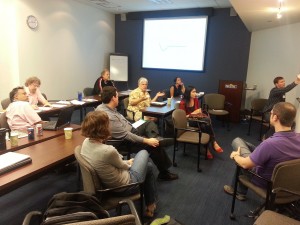Last week I had the privilege of attending a two-day meeting at the Field Museum’s Biodiversity Synthesis Center (BioSynC) hosted by museum botanist and early land plants collections manager Matt von Konrat. I joined faculty and students from several Chicago colleges and universities to discuss how to develop college curriculum for the taxonomic study of the liverwort genus, Frullania, one of many under-studied yet incredibly important bryophytes that are the oldest type of land plants and key bio-indicators of environmental degradation and climate change.

(photo: K. Lugo)
With the rise of molecular genetics and related disciplines since the 1950s, biology as a whole has seen a massive shift away from the traditional natural history-based disciplines of comparative anatomy and taxonomy, pursuits rooted in the 18th- and 19th-century study of nature. Yet the imperative to catalog and assess the world’s remaining biodiversity in our current age of mass extinction, a process largely driven by human action, means that current taxonomists working in museum collections and the field have a critical task ahead of them. The NSF-funded Connecting Biodiversity Research with Curriculum project spearheaded by the Field Museum’s Konrat and his colleagues is a creative way to involve students and non-scientists in the essential data collection and analysis work vital to cataloguing bryophyte species, re-assessing their place on the tree of life, and providing a model for similar work for other organisms.
For more on this endeavor, check out this post on the SUST at RU blog.